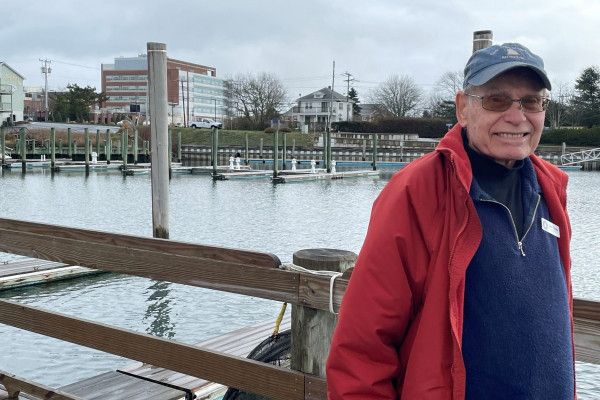
Don Stucke, curator at the Cape Cod Maritime Museum, with the location of Hyannis’ former fish shanties over his shoulder, nearby and below today’s Cape Cod Hospital.
By Seth Rolbein
“The fish shanties were right over there,” said Don Stucke, curator at the Cape Cod Maritime Museum in Hyannis, as he gestured across the inner harbor of Lewis Bay. “That white house over my shoulder on Lewis Bay Road, you can see it in the old photo of the shanties. Of course Cape Cod Hospital wasn’t there by a long shot.”
Most histories of Hyannis and its harbor don’t say much about commercial fishing, and these days most people don’t think of Hyannis as a fishing port as much as a ferry terminal, home for big pleasure craft, a place for the Kennedys to come about. But then as now, fishing played a major role.
The shanties, clearly visible in old maps of Hyannis, were one expression of that. They were built beside what was a shallow, marshy inner stretch of the harbor; only small boats and skiffs could make their way in. Thousands of schooners, mainly coasters, would come as far as the outer harbor, some tying up at Gage’s Wharf as early as 1795, but sparse facilities and bad overland connections made large-scale commerce difficult. Nearer to town, between what is now Hyannis Marina and Cape Cod Hospital, a private wharf called Lambert’s handled fish and other arrivals.
Much changed in 1854, when the Old Colony Railroad continued its Cape Cod expansion past Sandwich as far as Hyannis. Understanding how important a connection to the harbor and the private pier could be, the company added another mile or so of track from downtown (near where the multi-modal transportation building stands today) to the port. And to get past the shallow marsh that inhibited big boats, a huge railroad wharf was extended into the harbor, 1000 feet long, 200 feet wide, granite block lining the sides to support train traffic, an L-shaped pier at the end to facilitate unloading.
The real incentive for this big piece of infrastructure, strange as it might seem now, was Nantucket. The island was an economic powerhouse, whaling a big element, but moving product and goods to and from the mainland was cumbersome and expensive; the closest port was New Bedford, 80 nautical miles away. The new Hyannisport Wharf created a maritime hub only 25 miles from Nantucket, as well as a seamless railroad connection to Boston and markets beyond.
The wharf added onto a seafaring community that already existed, of course; one report from 1840 documented more than 200 “shipmasters” who owned homes in Hyannis. But the railroad, as it did in so many places, created opportunity and volume. By 1882, the wharf recorded 1500 ship arrivals carrying 6000 tons of coal, 100,000 bushels of grain, 1.25 million feet of lumber, and 4000 barrels of fish.
But the wharf’s utility was short lived. By the 1920s, dredging created deeper water and access to the inner harbor. The long railroad finger no longer was essential; the port was considered a hotbed of liquor smuggling during Prohibition, and the wharf even played host to an old whaling ship that served as a nightclub for awhile in 1928.
By 1931, even those kinds of commerce could not justify keeping the wharf alive. It was decommissioned, the railroad spur from downtown Hyannis abandoned. In 1937 the wharf was taken apart, its big granite blocks hauled farther out into the harbor to create a protective breakwater that still serves.
The maritime museum’s curator Don Stucke has pulled together a handsome small exhibit of the life and times of the railroad wharf that greets visitors on entering the Hyannis site – though many fewer are doing that these days because of COVID. Stucke has spent much of his 80-plus years in and around Hyannis, and lives in Centerville, so has seen plenty of changes himself. He’s a little apologetic that the exhibit doesn’t include more details on fishing and its relationship to the Hyannisport Wharf, but makes a promise:
“We’re working on an exhibit about the history of fishing in Provincetown,” with hopes to display in the late fall of 2021, he reports. “It’s really going to be great, so stand by.”
